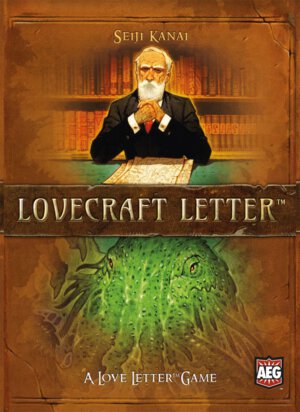Publisher: Alderac Entertainment Group
Designer: Seiji Kanai
Year: 2017
Players: Two to six players
Ages: 14+
Playing Time: Around five to ten minutes per round; a complete game in around 45 minutes
Genre: Hand management and card deduction game of the Cthulhu Mythos
Retail Price: $29.99
Outside the Box
Since I also happen to be a fan of near all things Mythos related, my interest was especially piqued when AEG announced Lovecraft Letter. I was also mighty curious how Seiji Kanai
If you’ve had a chance to watch the unboxing video above, you’ve already seen the production quality of Lovecraft Letter is top notch. From the tarot sized cards to the cool poker chips to the artwork throughout, AEG has really given the game a deluxe treatment. Granted, the MSRP of Lovecraft Letter is about three times that of the standard boxed edition of Love Letter but looking at the everything you get, as well as the excellent presentation, the price seems fair.
Rather than me just regurgitating the rules of Lovecraft Letter, feel free to check out the PDF right here if you’re interested in the nitty gritty.
Whereas the object of Love Letter was to manipulate your way to winning the hand of a princess, in Lovecraft Letter each of the players are trying to amass forbidden secrets mankind was not meant to know. All while eliminating your rivals along the way, of course. The game’s backstory actually involves a search for a missing cousin in Egypt but we thought that was a bit silly; all six players are trying to find a cousin? Are we talking about the same missing relative? Everyone has a missing relative? Who knows? I have to admit we sort of ditched that premise and approached the game as if we were each trying to unearth hidden Mythos secrets.
Lovecraft Letter adds some mighty interesting wrinkles to the established Love Letter format, not the least of which is the insanity mechanic. The original game contained sixteen cards with specific abilities and you would use these to not only take out the other players but to also try to hold a high enough value card in hand if the round came to a showdown of comparing values. Regardless of how you’d approach each round, each card only had one ability. In Lovecraft Letter the card count has been increased to twenty four (plus a Mi-Go brain case card) and some cards actually allow a player to choose one of two effects: sane or insane.
Once a player discards a card with an insane effect that player is now considered to have delved too deeply into the Mythos and gone insane. From that point on whenever that player discards a card with both a sane and insane option they may choose the insane effects. The insane options are always more powerful but they also come at a price since the player is much more likely to be knocked out of the round; prior to drawing their next card, the insane player must reveal a number of cards from the deck equal to the number of insane cards discarded in front of them. If they reveal another card with an insanity
I also want to mention the Mi-Go brain case card which begins each round out of the deck. This is a fun little nod to one of my favorite Lovecraft tales, The Whisperer in Darkness, where a player can discard the Mi-Go card and force another player to give them their hand and have to take the brain case card. Effectively, the target player’s brain has been carted off to Yuggoth and now they’re stuck with a zero value card which will automatically lose them the round if it’s discarded. A solidly nasty “take that” indeed!
Normally, Lovecraft Letter continues until one player has won two rounds while sane or three rounds while insane. These victory conditions remain constant regardless of the number of players. Yet, this wouldn’t be a Mythos game if Cthulhu didn’t get some top billing! There is an overall victory condition, regardless of the number of rounds any of the players have previously taken down, where discarding the Cthulhu card while having two or more insanity cards already in your discards nets you total victory. Honestly, this is a lot tougher to pull off than it sounds.
I have to say, without a doubt, Lovecraft Letter is my favorite title in the Love Letter line up. Seiji Kanai has done a marvelous job meshing a solid Lovecraftian feel to the proceedings and the game never feels as if we’re watching a designer flogging a dead horse in order to squeeze every last ducat out of a gamer’s pocket. I’m sure some prospective buyers might balk at the MSRP, considering you can buy the basic Love Letter online for around ten bucks, but I personally think the extra polish Lovecraft Letter receives is well worth the price. I have to say Lovecraft Letter has quickly replaced the original as what Cameron and his friends’ are clamoring to play whenever I stop by. In other words, if you’re a fan of previous entries in the series – and dig the Cthulhu Mythos – then Lovecraft Letter is seriously a must buy. If you haven’t played any of the Love Letter titles and want to give the series a shot? Go grab this game!
[rwp-review id=”0″]
- Chivalry & Sorcery Fifth Edition Reviewed - Nov 3, 2024
- Campaign Builder: Castles & Crowns Reviewed - Nov 2, 2024
- The Roleplaying Game of the Planet of the Apes Quickstart | First Look and Page-Through - Nov 1, 2024
